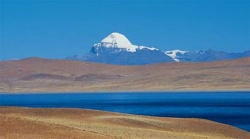Lake Manasarovar
Lying to the south of Mt. Kailash are two lakes. The western lake is known as Rakshas Tal. However, its neighboring lake to the east, Manasarovar , is by far the more significant of the two in a spiritual sense . is frequented by pilgrims almost as often as Mt. Kailash , and it is associated with many myths and religions. The limpid blue to emerald green colors of the lake, in contrast to the arid landscape immediately around it and the silver mountains beyond, help to make the lake a highly praised destination for pilgrims. is at an altitude of 14,950 feet above sea level, and is noted as the highest body of fresh water in the world. In former times, eight Buddhist gompas surrounded the margins of the lake. These were Trugo , Gotsuk (Gossul), Chiu , Cherkip , Langpona, Bönri, Seralung , and Yerngo .
To Buddhists, was seen to represent the Wheel of Life, with the hub at the center of the lake and the eight gompas representing the places where the spokes of the wheel connected with the rim. Thus, one full kora pilgrimage around the lake represented a single turning of the wheel, with all of the benifits that apply. The pilgrimage route, while hitting all eight gompas along the way, is about 64 miles long and takes two to four days to complete. If one just circumambulates around the shores of the lake, it is about 54 miles. Some Buddhists believed that the lake was identical to the legendary Anotatta Lake, where the Buddha's mother dreamt she had bathed and saw a vision of the Buddha appearing from the direction Kailash on a white elephant before he was born. There are several other Buddhist legends of the lake as well.Manasarovar is also worshipped by the Hindus , who believe that the lake was created by the god Brahma , the Creator. According to the Hindu belief, Brahma 's seven sons went to Mt. Kailash to visit and pay homage to Shiva and Parvati. Because they lacked a convenient source to perform ablutions, however, they asked their father if he could help them. So, Brahma obliged, and created the lake with a mental effort. As Brahma 's sons rejoiced at the creation, they saw a huge lingam (phallus) arise from the lake and worshipped it. The lake is also seen by the Hindu 's to be the home of the serpent Naga King and his subjects, living in the lake and feeding on the fruit of a giant jambu tree that grows in the middle of the lake. Sometimes, the tree drops its fruits and they fall to the bottom of the lake and turn into gold. In fact, gold has been found in the north-west corner of the lake near Chiu gompa, where it was mined for a while. However, the mining stopped due to an outbreak of smallpox, which was considered by some to be the wrath of the Naga deity . Another connection to Hinduism , is that the water fowl that frequent the lake are believed to be Shiva 's swan. A final connection to Hinduism , and more relevant to recent times , is that when Mahatma Gandhi died, some of his ashes were taken and scattered on in 1948.

